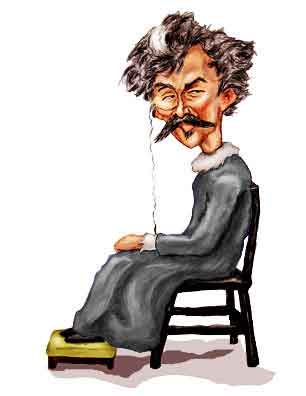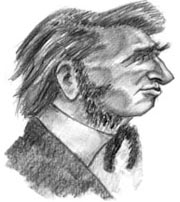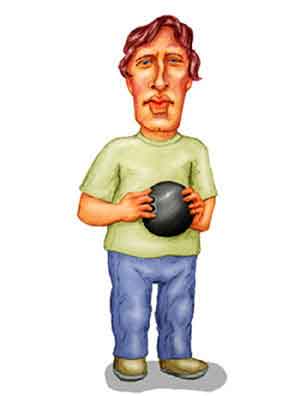James McNeill Whistler: The Paint Flinger
James McNeill Whistler is hailed as one of the greatest American painters. But Jimmy (as his friends called him) would have disavowed such a classification - at least regarding any national identity. In fact he spent relatively few of his 69 years time in his natal state. He once testified under oath he was born in Russia, and you can find some places that refer to him as an English artist.

James Abbott McNeill Whistler
The Not-So-Gentle Art of Making Enemies
Truth to tell, James Abbott McNeill Whistler was born in Lowell, Massachussetts in 1834. Although he was not born in Russia, he and his family moved to St. Petersburg when he was nine. George, his dad, was a civil engineer and had been hired to help to build the trans-Siberian railroad. But George died in 1849, and Jimmy and his mom, the former Anna McNeill, returned to America.
Jimmy had earlier shown a natural and strong talent in art, but that was not quite a fully respectable occupation in Mom's opinion. She wanted him to be a minister, but it was soon clear Jimmy didn't have the call. Still the family had good connections, and Mom wrangled her son an appointment to West Point where both his father and grandfather had graduated.
Of course, Jimmy was no more suited to a military career than one of the cloth. Although he did well in classes like mapmaking and art (where he amazed his classmates by his effortless draftsmanship), the common story is he could not pass chemistry and so got bounced from the Point. True, he did fail the third year chemistry examination, but ultimately it was Jimmy's non-authoritarian and wiseacre individualism that did him in. Jimmy had studied only what interested him, regularly violated the rules of conduct, and exhibted an insolent (some said arrogant) manner to his teachers and officers. So by the time his chemistry examination came around, he had amassed 218 demerits. Since 200 were sufficient for automatic expulsion, Jimmy's future military career came to a screeching and permanent halt. The commander of West Point - a military engineer named Robert Edward Lee - expressed regret that a young man of Jimmy's capability should have to suffer the consequences of actions that were his own doing. You can bet, though, that Jimmy was perfectly content with the decision.
For the next couple of years, Jimmy piddled around, working as a draftsman making maps where he was generally regarded as an unreliable employee. Like many aspiring artists he got along fairly well bumming off his friends and presumably with a little help from his mom's yearly pension of $1500 a year (a good income for the time). But finally Jimmy decided if he wanted to be an artist he had to study art seriously and that meant he had to go to Europe. He left America in 1855 at age 21 and never returned.
In that day and age, to study art meant to study in Paris. So that's where Jimmy went. He spent time copying paintings at the Lourvre and in general hooked up with the artistic community. Although naturally somewhat feckless by nature, Jimmy's talent soon attracted the attention of some important artists including Gustave Courbet and Eduoard Manet. Not particularly happy in Paris he moved to London. Once more he quickly attracted the attention of the critics and ended up with a painting exhibited at the Royal Academy. Such acceptance was enough to officially dub Jimmy an artist, and in 1863 he submitted a portratit of his girlfriend, Joanna Hifferman, to the official Salon in Paris. Although the painting was not accepted, this was the year of the famous Salon des Refusés where the painting was seen and praised. It is, in fact, one of his better works.
By the 1870's Jimmy had established himself as one of the leading - quote - "modern" - unquote - artists in Europe. But his work was still somewhat controversial. This was after all the era where the vogue was for highly finished romantic paintings depicting young Victorian women decked out in Greek stola or lolling about naked in a Turkish bath. But with the exception of his choice of colors (which tended toward muted "cool" tones), Jimmy could easily have been lumped in with the new and outrageous (but increasingly accepted) movement known as Impressionism, particularly after he shifted from portraits to landscapes. But Jimmy, then or now, was never considered an Impressionist.
In May, 1877, Sir John Coutts Lindsay, the owner of the new Grosvenor Gallery in London, held an exhibition. Sir John had established his gallery as an alternative to the Royal Academy, and at Grosvenor's the paintings were not selected by a committee. Instead Sir John himself extended his invitations to the artists who (with Sir John's consultation) decided what paintings to show. Jimmy was now well known in Europe and he exhibited eight paintings, one of which he called "Nocturne in Black and Gold".
"Nocturne in Black and Gold" - also called "The Falling Rockets" - is admittedly one of Jimmy's less typical works. It is a highly impressionistic - nearly abstract - painting of fireworks exploding over the Cremorne Gardens amusement park. Even as the most avid Whistler fams we have to admit it is a bit difficult to see exactly what it is Jimmy was trying to paint. John Ruskin, the famous art critic, by then an Oxford professor of Fine Art (and a decent artist himself), wrote a review of the show. By no means negative regarding the art or artists in general, John was a traditionalist and his criticism of Whistler was barbed in the extreme. Jimmy's work, he said, was neither to Grosvenor's nor Jimmy's credit, and he added that he "never expected to hear a coxcomb ask two hundred guineas for flinging a pot of paint in the public's face." These remarks, we hear, so raised Jimmy's already frizzled locks that he sued Ruskin for libel.

John Ruskin
In the process of going nuts.
Now it is true, that Jimmy had indeed "knocked off" (as he himself said) the painting in one or two days, and yes, he did ask for 200 guineas (i. e., 210 pounds) for it. That was a respectable price (even Jimmy admitted it was "stiffish") and represented about a year's salary for an office worker with perhaps 20 years of experience. But that wasn't the phrase - ungentlemanly as Jimmy thought it - that caused the problems.
There was (legally) a more serious statement in the same review (and in the same paragraph in fact). It seems that John had questioned not only Jimmy's artistic taste and technique but his motives. For all practical purposes, John said, Jimmy was deliberately painting garbage and pawning it off on a gullible public. Specifically, John wrote that "the ill-educated conceit of the artist so nearly approached the aspect of willful imposture". It was was that statement, Jimmy wrote in his reply to Ruskin, which was actionable.
(As an aside, it's really pretty easy to harbor the unworthy thought that an outlandish modern artists might be something of a put-on. After all, when Picasso had achieved fame and fortune and was selling pictures of people with with two eyes on one side of their heads, one of his friends said, "He could ---- on the floor and they would think that it was great." That, mind you, was one of Picasso's friends.)
The case of Whistler v. Ruskin underwent a number of delays, and the excuse was that John was in the process of going nuts. That's probably not true, and the real reason for the postponements is that John thought that appearing in a case with a pot-flinger was beneath his Oxonian dignity. But John did suffer off-and-on bouts of mental illness, and you can read it was because he was rejected in love. However the symptoms (which were described in detail by both John and his friends) indicate it was clearly some advancing and intermittent physical problem with his brain. Of course, at this late date actual diagnosis is not and cannot be possible, but a reasonable and recent suggestion is the CADASIL syndrome, an inherited disorder that leads to recurring strokes with symptoms of mental confusions, hallucinations, and delirium. In any case, John did not show up in court.
Given the long time it took to get the trial started, the proceedings themselves lasted a whopping eight hours, spread out over two days. Except for the abbreviated duration of the actual action, the proceedings strike the reader as surprisingly modern, particularly since much of the trial consisted of each side calling up - quote - "expert witnesses" - unquote - whose opinions (of course) supported the side that called them to testify. One of the more impartial witness was Albert Rossetti - a friend of both Whistler and Ruskin - who said the picture was not one of his favorites, it was not beautiful, but it was a work of art and was worth 200 guineas. Others said it was merely a sketch, hardly even a real painting.
Jimmy happily took the stand and testified with aplomb. His main point of justifiying a libel action was that after John's review he had not been able to sell many of his paintings - at least not at his previous prices. The attorney for Ruskin, Sir John Holker, asked if Jimmy was charging 200 guineas for a measly two days' work.
"No," he replied. "I ask it for the knowledge I have gained in the work of a lifetime." The spectators (at least some of them) broke into applause which brought on a stern warming from the judge that if manifestations of feelings occurred again he would clear the court.
In an effort to prove that Ruskin was simply giving an opinion shared by others, Sir John asked if anyone might fairly come to the opinion that the painting had no particular beauty. Jimmy said, "I have strong evidence that Mr. Ruskin did come to that conclusion." There was no applause here but the crowed did laugh which the judge tolerated.
Finally the case went to the jury. They ruled against Ruskin - they said his statement was indeed a libel - but awarded Jimmy only a farthing in damages - that is 1/48 of a shilling or a quarter of a penny. Since Jimmy won the case, he thought that John would have to pay the court costs. But no, since only "contemptuous" damages were awarded, the judge said each side had to cover their own expenses. In the end the verdict was a rebuke to both parties - to John for crossing the line of libel in a published review - and to Jimmy for wasting the time of the English courts because he didn't like what was written about a lousy art show. John had enough friends who pitched in and covered his fees, but the costs to Jimmy were enough that they added to the finances of his already impecunious lifestyle pushed him over the edge. He went bankrupt.

Oscar Wilde
Jimmy's Friend/Nemesis
To read some of the commentary about Whistler vs. Ruskin, you'd think that the case was a victory (although Pyrrhic) for Jimmy, and that the trial set some kind of precedence where art won out over critcism. The truth is the libel trial was a big mistake on Jimmy's part, and he should have just shrugged his shoulders and let John rant. In fact, even today a prudent attorney will caution prospective clients against rushing into libel litigation since regardless of the technical outcome of the case, the plaintiff often comes out looking worse than if they had done nothing. Louis Nizer, the famed New York attorney, likened libel to getting a patch of mud on your pants leg. It's better just to ignore it and let it dry. Then you can just flick it off, and most people won't even notice. Otherwise you'll end up smearing it all over yourself and people will forget it's just mud, not part of your pants.
Jimmy certainly had a not-so-gentle art of making enemies, a trait which in addition to his initiating his tiff with Ruskin, also sent him into a literary sparring match with the poet and dramatist, Oscar Wilde. Originally the men were on reasonable terms where good natured banter was the norm. It's probably apocryphal that upon hearing a particularly witty bon mot Osar said, "I wish I had said that!" to which Jimmy replied, "Oh, you will, Oscar, you will!" This is (perhaps) a pardonable distillation of an exhange in their letters to the editors duel where Oscar penned "With our James vulgarity begins at home - and should be allowed to stay there." To which Jimmy replied, "A poor thing, Oscar - but for once, I suppose, 'your own.'" Jimmy got the last barb in when Oscar was sent to prison for "acts of gross indecency" with various young men. On hearing the news, Jimmy cruelly remarked Oscar's next work would be the libretto for "The Bugger's Opera".
Jimmy did paint a lot of good paintings, and so it's ironic that his fame among the populace mostly rests with the portrait of his mother. It is a nice painting, sure, but Jimmy did a lot better. Known as "Whistler's Mother" to most, the real title (i. e., Jimmy's) is "Arrangement in Black and Grey, Number 1". Naturally the question is do we have an "Arrangement in Black and Grey, Number 2"? We do indeed, and that is a Jimmy's portrait of of the writer Thomas Carlyle (whoever he was). Tom is sitting in the same chair and in the same setting which gives his portrait the appearance of being a parody of the more famous first "Arrangement".
For years, "Whistler's Mother" had the distinction of being the only painting by an American to hang in the Louvre. Alas, that came to an end in the mid-1980's when the painting was moved to the Museum d'Orsay along with a lot of the more "modern" art works. And hanging in the same museum the work of another American artist, Winslow Homer. So Jimmy's position in the art world of France is no longer unique. Tough luck, Jimmy.
References;
There are two late twentieth century biographies that are a good introduction to Whister.
James McNeill Whistler: Beyond the Myth, Ronald Anderson and Anne Koval, Carroll and Graf (1995)
James Abbott McNeill Whistler: A Life, Gordon Fleming, St. Martin's Press, 1991.
There is also a volumous, early, and somewhat idolatrous biography which finds virtually no faults with the painter.
The Life of James McNeill Whister, Elizabeth and James Pennell, Lippincott (1908 original, reprint editions).
The Internet has quite a bit of (good) information on Jimmy. For those who want a quick sketch of Jimmy's life, check out his biography in Suzanne Michele Bourgoin's Encyclopedia of World Biography Gale Cengage (1997).
For the armchair biographer, much of Jimmy's correspondence are on the site named (what else?), The Correspondence of James McNeill Whistler at http://www.whistler.arts.gla.ac.uk/correspondence/.
Although this might seem a strange place to find primary source material about an American artist, the web site of the National Oceanic and Atmospheric Administration (NOAA) has a chapter where some people who knew Jimmy when he was a young draughtsman wrote down their recollections. That's at http://www.history.noaa.gov/art/whistler_pennell.html,
A Dictionary of Victorian London, Lee Jackson, Anthem Press (2006). The appendix lists the pay of a clerk ran from about 75 pound per year to 500 depending on seniority. The estimate above splits the difference.
"John Ruskin's Relapsing Encephalopathy", P. A. Kempster, Brain, v131(9), p. 2520 (2008). The Internet - as much as it can be criticized for doling out misinformation and superstition couched as "alternative" approaches - is becoming the place for published primary and reliable information. But watch out - the cost of the same information can vary inexplicably depending on which web page it's on. For instance, this paper can be purchased (with easy payments by credit card or PayPal) at http://cat.inist.fr/?aModele=afficheN&cpsidt=20607836. But if you search a bit more you can find the article for free at http://brain.oxfordjournals.org/cgi/content/full/awn019v1 which strange to say is the website of the actual journal. An (again free) pdf file is available http://brain.oxfordjournals.org/cgi/reprint/awn019v1.
CooperToons recommends you get the free copy.